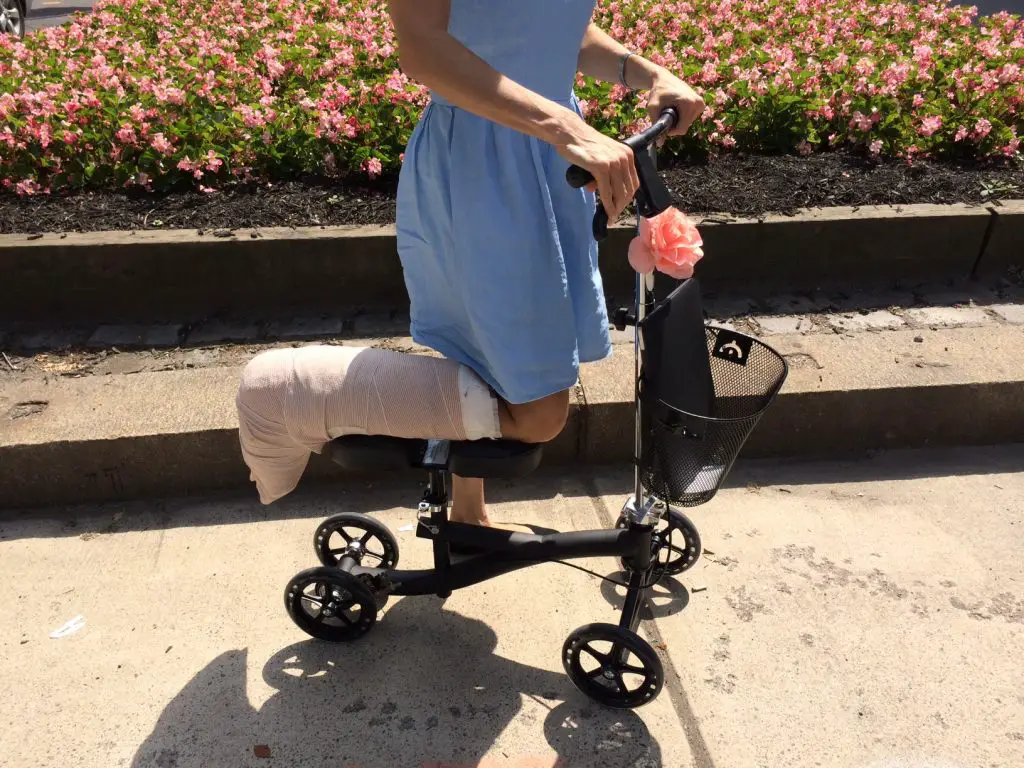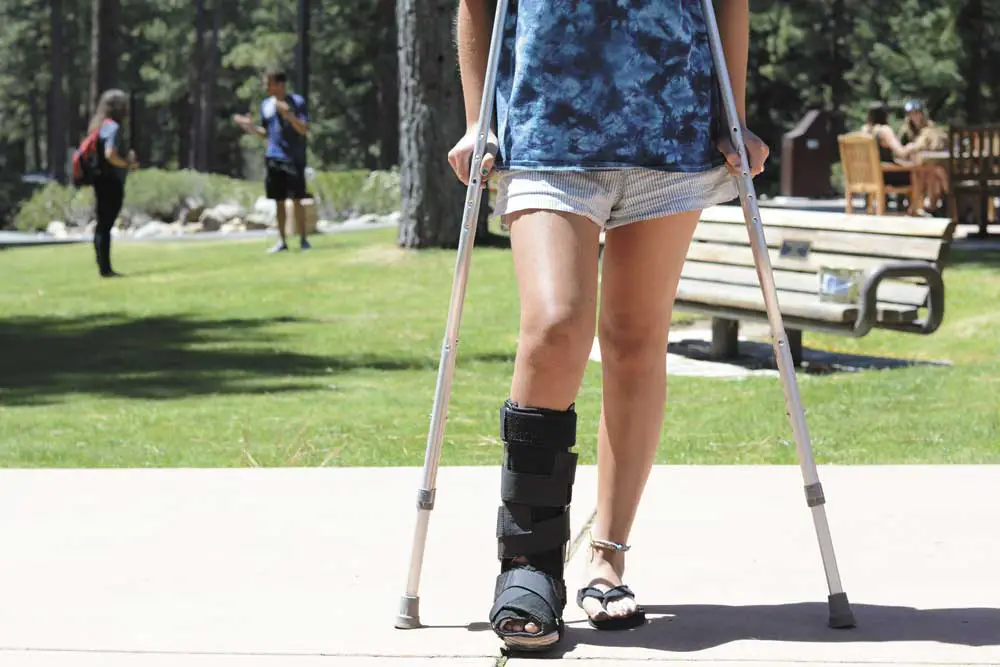I’m from a small town near San Diego, California, and down here in the land of palm trees and eternal sunshine, we don’t really have winter. So, when I moved to New York for college, I was ecstatic to finally experience snow, ice and bone-chilling temperatures.
Unfortunately, I was not prepared for what happens after snow melts—it freezes over. One day, I was walking from the subway to class (in impractical, tread-less shoes), and, in my predictably clumsy way, I slipped on the ice. As my ankle folded under me, I heard a resounding crack.
One broken fibula, two casts and about three months later, I could finally walk again. Navigating college on an injury was a harrowing experience, but I did pick up a few hacks to make the whole process less painful (literally and figuratively). Now, fully healed and thankful for it, I can share the tips I learned with you.
1. Have the Right Tools
Depending on exactly how they’re injured, each person will have a different experience with casts, limited mobility and doctor’s orders. I broke my ankle, so I had a cast (which I couldn’t get wet) from my toes to my knee; I was unable to put weight on my left foot, and I had to get around using crutches.
Right off the bat, this made life difficult; crutch-walking is completely doable for short distances, but three of my classes were at a different campus from the one where I lived. To get class I had to walk from my dorm to the front of Fordham’s Lincoln Center campus, then get on the intercampus van to Fordham’s Rose Hill campus, then walk from the van drop-off point, on one side of campus, to my classroom building, on the other side. By the time I got home after my first day back at school, my backpack weighed a thousand pounds, my arms felt like noodles and even my working foot was sore.
Since I was looking at two to two-and-a-half months of being unable to put any weight on my ankle, I began to research equipment that might make my life easier. Eventually, I bought a device known as a knee scooter; yes, it’s exactly what it sounds like. Check out this one, this one and this one—or just search “knee scooter” on Amazon, and make sure to check with your doctor being buying, just in case. Of course, if you’re in a full-leg cast, a knee scooter won’t be practical, and if you are able to walk it would be pointless—devices such as these tend to be relatively expensive as well, so evaluate how much you would use the alternative to crutches before spending the money. Speaking personally, however, my knee scooter was an absolute life-saver.

Now that I had a new-and-improved method of travel, I had to face what had, since my injury, become the most daunting task of all time—showering. What had once been a peaceful fifteen minutes of soap, shampoo and singing (badly) had become a traumatizing half hour of balancing on one foot, falling into walls and trying not to drown. After an incident involving a loss of balance, a desperate attempt to catch hold of the shower’s temperature control and a completely ripped-off fingernail, my roommate rushed out and returned with hydrogen peroxide, bandages and a shower stool. In case the moral of my little anecdote wasn’t clear enough, if you can’t put weight on one of your legs, I highly recommend a shower stool—it may save you a few weeks of waiting for your fingernail to grown back.
Finally, there is one thing that everyone with a cast needs to know, and that is how to keep said cast from getting wet. You can take the easy way out—like I did—and buy a cast protector (they are pretty cheap on Amazon, see here, here or here), or you can learn to wrap your cast using household items. I found the most effective way was to start with a layer of plastic wrap, then cover it all with a plastic grocery bag (tucked into the top of the cast) and finish up by using waterproof tape to hold it all together—make sure to tape the grocery bag to your skin so no water gets inside the cast. Of course, using these items over and over will take time and may eventually cost just as much as simply buying a cast protector.
2. Ask for Help
The first time I rode my knee scooter to class, I had to face down an obstacle I had never realized was an obstacle—the escalator. Even on crutches I could hop on without a problem, but now? Impossible. I was standing around, confused and panicking over my impending lateness to class, when a security guard walked up and looked at me. He asked me if I knew where the handicapped elevator was, and I responded with a clueless stare. He laughed, led me around a corner and introduced me to a secret elevator with priority access to each floor. That was the first time a stranger kindly helped me out, but it wouldn’t be the last.
Eventually, I learned to ask for help when I needed it, and I discovered a whole network of resources I hadn’t even known existed. Campus security picked me up from the Bronx hospital where I had my appointments, the drivers of the intercampus vans let me have shotgun and the security guards at my dorm opened doors when I needed them to.
I’ve never been the sort of person who asks for help—I am stubbornly independent and I never like to feel like I need anyone else’s assistance—but once I started to ask, people were only too happy to lend a hand. I’m not advocating complete dependence, but when you’re seriously injured, life is hard enough without trying to handle it alone. You may be surprised at how much more bearable life gets if you are willing to ask for help.
3. Focus on the Positive
As hard as the physical side of being injured was, and as much of an ordeal as it was simply to get where I needed to go every day, the mental side was the toughest. I go to school in New York, and my favorite thing to do is to walk around the city, sometimes with a destination, sometimes just for the fun of it. Suddenly losing my ability to explore the city, along with my mobility, independence and a large part of my social life, took its toll. I was lucky, though, that I have a great group of friends and roommates who were always down to hang out in our living room and watch movies or “The Bachelor” instead of going out.
While being injured, I learned a lot about my school and how willing everyone there is to help a girl out; I also learned not to be afraid to ask for help when I need it. The best lesson I learned from the months I was unable to walk, however, was the need to focus on the good in life. I have a tendency to wallow whenever something goes wrong, then, after an appropriate amount of time, pull myself together and fix it. But, there’s no fixing a broken ankle, just a long period of waiting for it to get better. To endure the wait, to keep my spirits up even when I felt like I was missing out on the parts of life I enjoyed the most, I had to remember what I still had.
My teachers were understanding and sympathetic. Strangers on the street held cab doors open for me. My friends were fantastic and supportive in whatever ways they could think of. And hey, there were even some positives to being unable to walk: My friend and I ended up getting third-row seats to the musical “Waitress” because I couldn’t climb up the stairs! So, here is my final and most important piece of advice to any college student affected by an injury: It will heal, you will be okay and in the meantime, try to focus on the positives in your life, whatever they might be.

















